Consecutive Chain Neighbor Reduction
In Consecutive Sudoku, if the cells cell1 and cell3 is having a common neighbor cell2. Then the possible values of cell1 is based on the possibility sequence of cell2 & cell3 and the possible values of cell3 is based on the possibility sequence of cell2 & cell1.
An illustration for the above concept.

In the Rectangular block, consider the cells cell1 - (0,1) cell3 - (2,1) having the common neighbor cell2 (1,1). These cells are consecutive to each other.

Here, the possible values of cell1 is based on the possibility sequence of cell2 and cell3 (i.e) if the cell1 is assigned
with the value 2, then the cell2 will have the consecutive value -3 & the cell3 will have the consecutive value -4 and the
same is applicable for all the other values in cell1. Since the cell1 doesn't contain value 3, there is no chance for the cell3
to be assigned with the value 5. Therefore the value 5 is removed from the cell3.
Consecutive Sudoku Algorithms Greater Sudoku AlgorithmsAlgorithm Links



